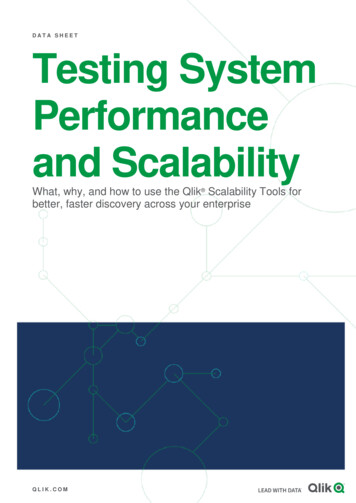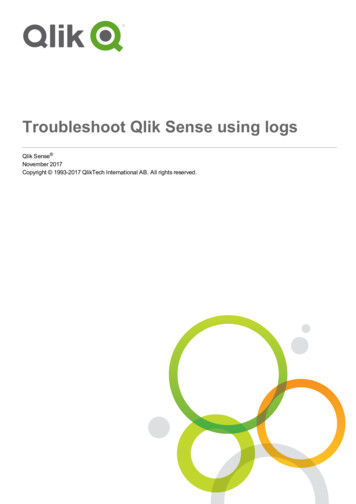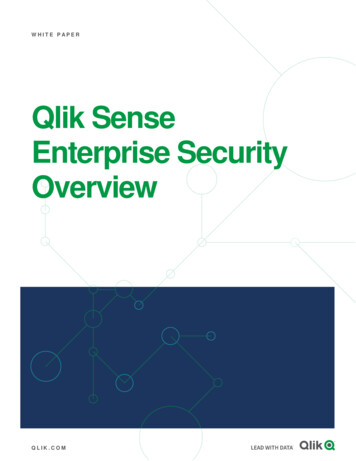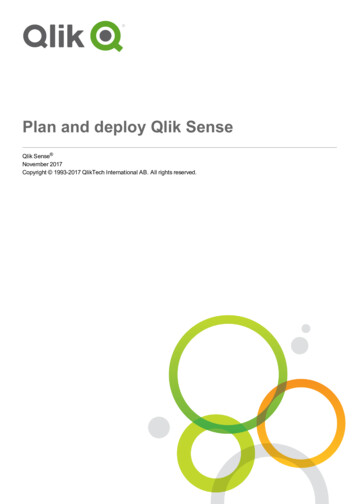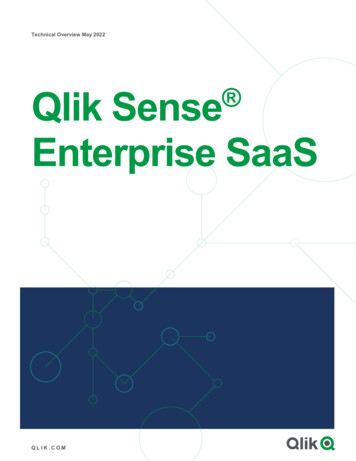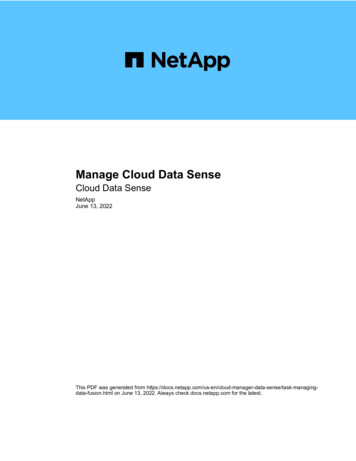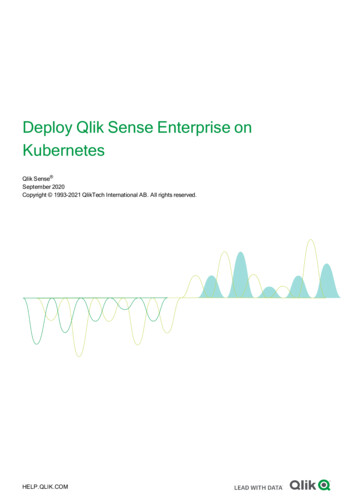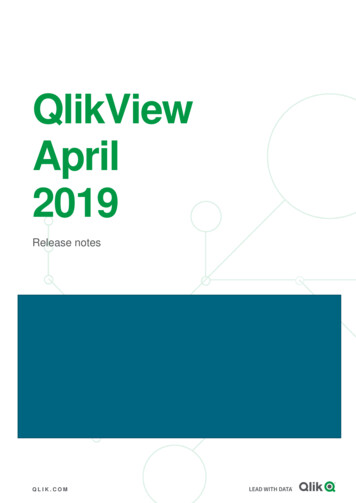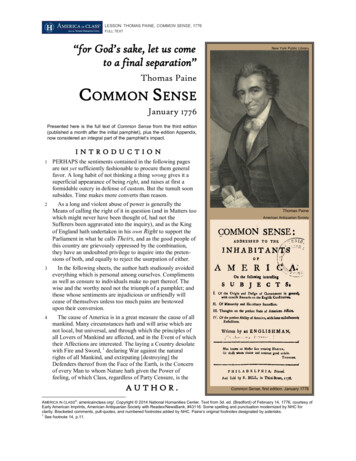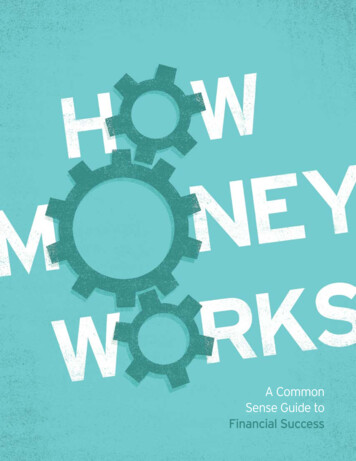
Transcription
A CommonSense Guide toFinancial Success
TABLE OF CONTENTSTake Control4Pay Yourself First6Use Time and Consistency8Pay Off Debt12Buy the Right Kind of Life Insurance16Defer Taxes22Become an Owner, Not a Loaner26Invest with Professional Management29You Can Do It!How Money Works is a publication of Primerica andis proudly distributed to help consumers find answers to their financial problems. It is not intendedas a sales solicitation, but as an overview of how toovercome the most common financial challengesfacing people today.Primerica believes the ultimate key to financial success is knowledge — about how money works, how tomake responsible, well-informed decisions and how toget the best value for the dollars you spend.That’s what How Money Works is all about. As partof Primerica’s continuing commitment to consumer education, this book is a general introduction to the basic,common sense financial concepts that can help people31overcome the obstacles they face and achieve theirgoals. It shows how greater financial security is withinreach of every working American.As the text explains, the critical first step islearning to make wise financial decisions. Primericaencourages consumers to become independentthinkers and always make their own choices, whetherthey’re purchasing financial products or any othergoods or services.Primerica offers a wide variety of consumeroriented financial solutions. For more information onspecific products, contact the Primerica representative who gave you this brochure.
There is a common misunderstanding that average and ordinary folks can’tbecome millionaires.That couldn’t be further from the truth.The fact is, you have the power to accumulate wealth beyond your dreams. Manypeople who have never earned a six-figure income become financially independent.How do they do it? Doesn’t it take a high-level job with a big salary? Or a largeinheritance? Or winning the lottery?The answer is no. No matter what your income level, you can achieve financial security—if you take the time to learn a few simple principles about how money works.YOU CAN get out of debt.YOU CAN build savings.YOU CAN get on the path to financial independence.By applying the simple principles in this book, you can achieve financial security andultimately reach your goals. But nobody else can make it happen.It’s up to you. You have the power to change your life forever.READY TO GET STARTED?
TAKECONTROLDid you know one of the biggest financialmistakes most people make is dependence?Dependence on others allows “outside”factors in people’s lives to control them.The secret to financial security is learningto control the things you CAN control.Pay Yourself FirstAs you begin your journey to financial independence,Paying yourself first means putting yourself and youryou keep.family before any other demands on your money. Payingyourself first is a form of self-respect.Deposit a set amount each and every monthinto an investment program, no matter what other finan-remember this key point: It’s not what you make, it’s whatChange Your ThinkingThe way you think about money is everything. Your mindsetis a powerful thing — especially when it comes to money.cial obligations you have. It’s amazing how fast your mon-That explains why so many of the people who win theey can grow if you invest even a small amount regularly atlottery end up losing it all. It helps you understand howa good rate of return.so many millionaires are self made.What is the difference between the two groups? It’sAdjust Your Prioritieshow they think. If you think you don’t deserve to be finan-It’s been said that:cially secure, you’ll never be financially secure. However, ifIf you make 10 and spend 9 happinessyou “upgrade” your self-image and believe you deserve theIf you make 10 and spend 11 miseryfreedom and peace of mind that financial security provides,
you’ll have a better chance of doing what needs to bewith banks. You can take money from a 1% savingsdone to obtain wealth beyond your dreams.plan and invest it in an area that has the potential forAdjust Your Lifestylehigher returns.2. High-cost life insurance. You can replace yourAlong with setting priorities comes one tough ruleoutdated, expensive cash value insurance policiesof life: You can’t have everything. You have to makewith term insurance and potentially save thousands ofconscious decisions about every purchase.dollars in premium over time! Both of these areas areAn important concept to understand is want vs. need: A need is something you have to have, something youcan’t do without. You “need” food. You “need” shelter. A want is something you would like to have. You“want” ice cream. You “want” a bigger house.If you want to achieve financial independence, youcovered in more detail later in this booklet.Avoid the Credit TrapCredit cards are good for convenience but that’s it.Be careful to avoid the pitfalls of “plastic money.”Pay your balance in full each month and you’ll not onlyavoid interest charges but you’ll prevent your balancemay have to make sacrifices for a period of time and gofrom escalating out of control. To keep your monthlywithout some of your “wants.” It’s not that tough, but it ischarges under control, pay with cash. You’ll probablyvery, very important to your financial health.find you spend less when you have to hand yourEarn Additional Incomemoney over.If your family income is very modest, things may be sochoice about your financial future.tight that it’s tough to invest more than 50 a month.If you want to make significant progress, considertaking a part-time job to get the extra incomeneeded to start your investment program.Realign Your AssetsThis is another way to take control and free up incomefor savings. There are two major areas in whichfamilies are not getting their money’s worth that aregreat areas to target for adjustment:1. Low-interest savings accounts or accumulationsSee how many options you have? You DO have aSet Goals and Have a PlanYou can’t reach your destination if you don’t knowwhat it is. Setting goals gives you two things:1. An incentive to make the necessary sacrifices2. Benchmarks along the way to gauge your progressAfter you’ve set your goals, you need a road mapto get you there. You need a financial game plan.Together with your goals, a game plan is the cementthat holds together your financial foundation.You Cannot ControlBut You Can Control The Future of Social Security Saving for Retirement Your Employer Other Sources of Income Taxes Ways to Reduce Your Taxes Inflation Maximizing Your Savings Rising Costs Saving More The Risk of a Single Investment Diversity of Your Investment ChoicesDiversification does not assure a profit or protect against loss.5
PAYYOURSELFFIRSTPROBLEM:At the end of the month, most peopledon’t have anything left to save.SOLUTION:At the first of the month, before you pay anyoneelse, write a check to yourself for 10% of yourincome. Paying yourself first may be the singlemost important concept in this brochure.
It’s Not What You Earn,It’s What You KeepCalculate How Much You’ve Earned& How Much You’ve SavedPut yourself at the head of the line. Treat your savingsAverage annual income (estimate):like any other recurring bill that you must pay eachmonth. Dedicate the appropriate amount from yourpaycheck and set it aside. While most people thinknothing of sending enormous amounts of money tocredit card companies on a regular and systematicATimes number of years worked:X BEquals total amount earned: CAmount of personal savings:DDivide D by C: E%basis, they balk at the idea of paying themselves first!Change that mindset. Cut up your credit cards andThis equals your percentage of income saved.put those payments into your own savings. Make acommitment to pay yourself first!The Three Accounts You NeedTo have a complete savings program, most people need three types of basic accounts:EMERGENCY FUNDSHORT-TERM SAVINGSThis is your reserve fund inThis account is for money thatthe event of an unforeseenyou set aside for expenses youThis is where your retirementemergency, job loss or anwant to purchase within a short-savings, college fund andunexpected expense.term time frame. For example,other long-range savings willA good rule of thumb:here is where you would savego. Because these savingsSet a goal of having threefor a new computer or perhapshave more of a long-term timeto six months’ salary ina vacation.horizon, you can use investmentyour emergency fund.LONG-TERM SAVINGS& INVESTMENTSvehicles with potential for ahigher rate of return, such asequity mutual funds.Investing entails risk including loss of principal. Shares, when redeemed, may be worth more or less than their original value.7
USE TIMEANDCONSISTENCYSomeone once said that the only two thingslife gives you are opportunity and time.Time, combined with two other importantelements, rate of return and consistency, is apowerful key to achieving financial security.
It Pays to StartInvesting EarlyAmount Accumulated by Age 67 406,466Suppose your parents had deposited 1,000 on the dayyou were born. If you left the account untouched until youturned 67, that 1,000 would have grown to 406,466 — 96,822without you ever having to add another penny!The rate values to the right are at age 67 and for illustrative purposesonly and do not represent an actual investment. This example uses aconstant rate of return. Actual investments will fluctuate in value. The illustration does not include fees and taxes that would lower results. The9% rate of return is a nominal interest rate compounded on a monthlybasis. Investing entails risk, including loss of principal. Shares, when redeemed, may be worth more or less than their original value. 11,256If Paul’s parents invested 1,000:At BirthAt Age 16At Age 40Don’t Pay the High Cost of WaitingIf you’re like most people, you don’t have a lot of money. That’s why time is so critical. When you’re young, you can save smallamounts and still end up with thousands of dollars. If you wait to begin saving, you must save much more. If you want to befinancially independent, you have no choice — you must start now, or later you must save more. One thing is certain: You can’tafford the high cost of waiting.If your goal is to save 500,000 for retirementat age 67, look at the difference time makes:The sooner you begin to save, the greater thegrowth on your investment:Monthly Savings RequiredThe High Cost of Waiting ( 100/month at 9%)BeginSaveCost to waitBeginAge 25 89—Age 25Age 35 224more than 2 times moreAge 26Age 45 602nearly 7 times moreAge 30 357,240 209,680Age 55 1,926more than 21 times moreAge 40 137,780 429,140Total at Age 67 566,920 517,150Cost to wait— 49,770These examples assume a hypothetical 9% constant rate of return. Rate of return is a nominal interest rate compounded on a monthly basis. Actual investmentswill fluctuate in value. The illustration does not include fees and taxes which would lower results. Investing entails risk, including loss of principal. Shares, whenredeemed, may be worth more or less than their original value.Add Consistency to TimeYou’ve seen how time can be the best friend of growth. But most people don’t have 1,000 to deposit all at once. They must dependon smaller amounts, invested on a schedule, to build wealth. If that’s your situation, consistency can be the fuel that makes yourinvestment grow exponentially.9
The Power ofCompound InterestJust a Little More Grows Even FasterRemember the parents who deposited 1,000 at aincreased dollar amount definitely pays off. Just 100hypothetical rate of return of 9% when their child wasa month compounding at a hypothetical 9% rate totalsborn? The annual interest would be 90. And 90/more than 470,000 after 40 years.The chart below illustrates the difference betweensaving 20 a month versus 100 a month. While saving 80 more a month may be a challenge financially, theyear, when multiplied by 67 years, is 6,030. Thenhow did Paul withdraw more than 406,000 at ageMonthly Contribution67? Because of one of the most important keys towealth you can ever learn: the power of compound 20 10010 3,900 19,500or 90, was credited to the 1,000 to make 1,090.20 13,460 67,300The next year, 98 was earned on the 1,090. The30 36,890 184,450total in the account was then 1,188. As the account40 94,330 471,650Yearsinterest. Here is how it works:The first year’s interest on the investment, 9%grew each year, the interest payment was calculatedon the total in the account, including all the pastThis is hypothetical and does not represent an actual investment. Actualinvestments will fluctuate in value. It does not include fees and taxes whichwould lower results. Rate of return is a constant nominal rate, compoundedmonthly. Investing entails risk, including loss of principal. Shares, when redeemed, may be worth more or less than their original value.interest payments. The compounding of the interestis how 1,000 grew to more than 406,000. With thepower of compound interest at work for you, you’llbe amazed at how quickly a few hundred dollars canbecome a thousand.Do You Know the Rule of 72?Another important concept in understanding the power of compound interest is the Rule of 72. Your money will double at acertain point determined by dividing 72 by the percent of interest.3%6%12%0 10,000 10,000 10,0006—— 20,00012— 20,000 40,00018—— 80,00024 20,000 40,000 160,00030—— 320,00036— 80,000 640,00042—— 1,280,00048 40,000 160,000 2,560,000YearsBased on the Rule of 72,a one-time contribution of 10,000 doubles six moretimes at 12% than at 3%.Compound interest isthe most powerful forcein the universe.Albert EinsteinThis table serves as a demonstration of how the Rule of 72 concept works from a mathematical standpoint. It is not intended to represent an investment. The chartuses constant rates of return, unlike actual investments which will fluctuate in value. It does not include fees or taxes, which would lower performance. It is unlikelythat an investment would grow 10% or more on a consistent basis.10
The Importance ofRate of ReturnWe’ll use the example of Paul’s parents investing 1,000 at his birth on page 9. Let’s look at their onetime 1,000 investment with a 3%, 6% and 9% rate ofThere’s another critical key to building financial securityreturn. Look at what Paul could have withdrawn at age67 at various rates of return.that’s often overlooked. It’s the interest rate (sometimesreferred to as the rate of return). The difference of a fewA one-time 1,000 investment with a 3%, 6%and 9% rate of return:percentage points may seem minor, but the impact ofthe rate of return when combined with time is significant.You might think that if you could earn a 9% rate of9%return instead of 4.5%, your money would double. Not 406,400so! Remember the “power of compound interest?” That4.5% difference adds up to much more over time — and6% 55,100can mean thousands of dollars for you and your family.3%Rate of Return in Action 7,400Now you can see why the rate of return youreceive on your savings or investment account isso important. Your main objective in saving is toaccumulate as much cash as possible. You can reachthe same objective in one of two ways:1. Save more and accept a lower % ORHypothetical percentage rates and values. Rate of return is a nominal interest ratecompounded on a monthly basis. These results are not indicative of any specific investment and show a constant rate of return, where an actual investment will fluctuate invalue. It does not include fees and taxes, which would lower results. Investing entailsrisk, including loss of principal. Shares, when redeemed, may be worth more or lessthan their original value.2. Save less at a higher %How Doubling Your Interest Can Quadruple Your Savings 100 per month at 4.5% and 9% 750,000 746,0409%4.5% 500,000 250,0000 Years 175,25051015202530354045Hypothetical percentage rates and values. Rate of return is a nominal interest rate compounded on a monthly basis. These results are not indicative of any specific investment and show a constant rate of return, where an actual investment will fluctuate in value. It does not include fees and taxes, which would lower results. Investing entailsrisk, including loss of principal. Shares, when redeemed, may be worth more or less than their original value.11
PAY OFFDEBTOf all the threats to your financial security, none ismore dangerous than debt. In every family’s questto feel good financially, debt is the most commonenemy. The very fact that it is so common – whodoesn’t have debt? – makes it one of the biggestthreats to your financial well-being.
The Bad News aboutCompoundingDid you know if you made a one-time 3,000credit card purchase with an 18% interestrate with no new purchases and made theminimum payments, it would take at least 10years to pay off and you would end up payingmore than 2,002 in interest charges?Compound interest is one of the most powerfulfinancial forces around. When you are building savings,its power works in your favor. However, when you havedebt, the power of compound interest works againstyou! When you pay just the minimum balance on yourcredit cards each month, interest charges are added tothe remaining principal. This means your new balanceis the principal PLUS the interest and that amountgets compounded again and again. It’s easy to see howsmall debts grow large quickly with compound interest.PURCHASEINTEREST3,000 2,002 5,002 Assumes 18% APR, and a minimum payment of 3.5% of the balance or 20 if more.Revolving Debt vs. Fixed DebtCredit card debt is what is known as “revolving” debt. The interest compounds daily instead of monthly, which means youcan pay much more in interest. Because there is no fixed amount that you pay each month, your debt can go on forever.Additionally, your interest rate could change at almost any time and there is little a consumer can do beyond paying off theentire balance at once.Look at how revolving debt can erode your financial security:REVOLVING DEBT 17,000 @ 18% 595/month*FIXED DEBT 17,000 @ 18% 595/month fixed** 12,500 IN INTEREST PAID17 years and 2 months to pay off 5,370 IN INTEREST PAID3 years and 2 months to pay off*Assumes revolving payment (minimum) is 3.5% of the remaining balance or 20, whichever is greater. First month’s payment is shown and term assumescontinued payment of minimum amount with no additional amounts paid. No additional debt is incurred and payments decrease over time period. **Assumespayment of 3.5% of initial loan amount, no additional debt incurred and initial payment amount remains fixed throughout term of loan.13
Debt Stacking Can Lead to Debt FreedomIf the idea of paying off your debt seems overwhelming, consider debt stacking. They say you can eat an elephant —one bite at a time. Well, the same concept works with paying off your debt! By taking into account the interest rate andamount of debt, debt stacking identifies an ideal order for you to pay off your debts. You begin by making consistentpayments on all of your debts.The debt that debt stacking suggests that you pay off first is called your target account. There are programs you canenroll in that will automatically select your target account for you using a variety of criteria to help you get out of debt faster.When you pay off the target account, you roll that payment into the payment that you were making on the next targetaccount. These extra dollars help you reduce the effect of compound interest working against you. As each debt is paid off,you apply the amount you were paying to that debt to the payment that you were making on the next target account.Debt stacking allows you to make the same total monthly payment each month (in the example it is 2,720 eachmonth) toward all of your debt and works best when you do not accrue any new debts. You continue this process until youhave paid off all of your debts. When you finish paying off your debts, you can apply the amount you were paying towardyour debt toward creating wealth and financial independence!Debt StackingTarget AccountAs each debt is paid off, you apply theamount you were paying toward thatdebt to the payment that you weremaking on the next target account.Extra Debt Payment AmountRetail Card 1: 220 573Credit Card 2: 353Credit Card 2: 573Car Loan: 551Car Loan: 551Car Loan:Credit Card 1: 303Credit Card 1: 303Credit Card 1:Mortgage: 1,293Total: 2,720CategoryPayoffInterest AvoidedInterest PaidMonthly Payments14 220Mortgage: 1,293Total: 2,720Without Debt Stacking23 YearsMortgage: 1,124 303 1,293Total: 2,720With Debt Stacking9 Years14 Years Sooner 0 130,643 214,442 83,799 2,720 2,720 1,124Credit Card 1: 1,427Mortgage: 1,293Total: 2,720 1,427Mortgage: 2,720Total: 2,720This example is for illustrative purposes only. The Debt Stacking concept assumes that: (1) you make consistent payments on all of yourdebts, (2) when you pay off the first debt in your plan, you add thepayment you were making toward that debt to your existing paymenton the next debt in your plan (therefore you make the same totalmonthly payment each month toward your debts), (3) you continuethis process until you have paid off all of the debts in your plan. Inthe example above, when Retail Card 1 is paid off, the 220 paymentapplied to Retail Card 1 is applied to Credit Card 2, accelerating its payment to 573. After Credit Card 2 is paid off, the 573 payment appliedto Credit Card 2 is applied to the Car Loan for a total payment of 1,124.The process is then continued until all debts are paid off. Note thatthe total payment per month remains constant. The hypothetical assumes a constant nominal 9% rate of return compounded monthly,unlike actual investments which will fluctuate in value, and does notinclude taxes or fees, which would reduce returns. Investing beginsonce debts have been paid off (at age 44).
AVOIDTHESECOMMONCREDITMISTAKES3Not Monitoring YourCredit HistoryKnow where you stand. Lenders andprospective employers get a snapshot ofyour debt repayment history with yourcredit report, and it is important for youto know what they are seeing.41Not Monitoring YourCredit ScoreNot Valuing Your CreditA good credit score can determine a lot ofGood credit is a valuable commodity inthings today: Whether you will be approvedtoday’s world. Bad credit, including a badfor credit, the interest rate on your loans,credit record, late payments, etc., canthe cost of your homeowner’s and autocreate a negative financial profile thatinsurance or whether you will be approvedcan surface when you have a legitimateto rent a house or an apartment.need to borrow.52Raising Credit Card LimitsNot Knowing Your InterestRate and FeesIf you use credit cards, avoid raising yourFees vary widely among credit cards.limit. An increased limit is merely anAlways make sure you know what theincreased temptation to buy. If a companyinterest rate and annual fees are beforenotifies you that they are raising youryou accept the card.credit limit, take that as a warning signal.Chances are you’ve been using your creditcard for more than emergencies.15
BUY THERIGHT KINDOF LIFEINSURANCEOne of the most important expenditures theaverage family should make is life insurance. It isalso one of the most misunderstood. It is absolutelycritical that you make the right decision about thekind and amount of life insurance to buy. In fact,the wisdom of your life insurance purchase couldmake a major difference in your family’s security,should you die, and your quality of life if you don’t.
The Importance of Life InsuranceHow much is your car worth?Do you insure it?How much is your house worth?Do you insure it?How much is your life worth?Probably a lot more than your car or your house!Can you afford NOT to insure your life?What’s its purpose?Life insurance should really be called “death protection” because its purpose is to protect the family against thepremature death of a breadwinner or a caregiver. It acts as a substitute for income. Remember when you calculatedhow much you’ll earn in your lifetime? It was a fortune, wasn’t it? The potential risk of losing that earning power is whatmakes life insurance a necessity.Who should buy it?Mainly people who have others depending on them for income support. If you have a non-earning spouse and/or children, orsome other significant financial obligation, you need life insurance. Your spouse may also need coverage, even if he or shedoesn’t work, if child care or other expenses would result from the spouse’s death. If you’re single or have significant cashresources, you probably don’t need it.What should you buy?Inexpensive term life insurance. A common misconception about life insurance is that it is a permanent need for each family.Most financial experts see it as a way to simply “buy time” until you accumulate savings, not as a permanent fixture in yourfinancial program.17
How Life WorksAccording to the Theory of Decreasing Responsibility (illustrated below), your need for life insurance mirrors familyresponsibilities. When you’re young, you buy low-cost death protection, term insurance, enough to protect the loss of yourearning power, and put the maximum amount you can afford into a promising investment program. When you’re older,you may have much less need for insurance coverage. If you’ve saved and invested wisely you should have a significantamount of accumulated cash. You’ve become “self-insured” and eliminated your need for life insurance.The Theory of Decreasing ResponsibilityIn the early years, you mayneeda lotofYou’d better have moneycoverage.oneyYou may not have a lot of mTodayYoung childrenHigh debtHouse mortgageLoss of Income Would Be DevastatingIn the later years, you may notAt RetirementGrown childrenLower debtMortgage paidRetirement Income NeededHow Much Is Enough?If you’re like most Americans, probably more than you have! Ten times your annual salary is a good rule of thumb.Whatever coverage you choose, buy only one policy, and put the entire coverage amount on that policy. Separate policiesmean separate fees and could cost far more!CONSUMER TIP:Buy life insurance exactly like you buy other kinds of insurance — auto, homeowners, health— for protection only.Wouldn’t you think it was silly if someone tried to sell you auto insurance that included a long-term savings plan?The same is true for life insurance. It pays to buy your insurance separately.REMEMBER: Do not combine your savings with your life insurance.18
Some Questions About Cash ValueWhen it comes to life insurance, you have two basic choices: some form of cash value life insurance (including universallife) and term life insurance. In cash value insurance, as a “bundled” policy, you buy both your death benefit and a cashvalue feature. However, this doesn’t enable you to maximize the benefits of the Theory of Decreasing Responsibility.These concerns have led many leading financial writers and consumerists to direct consumers away from cash value.Buy Term and Invest the DifferenceWith the “Buy Term and Invest the Difference” model, you have greater control over your benefits. Because protection andsavings are completely separate, you can better control the death benefit and the investment portion.Cash ValueTermTypically higher initial premiumsLower initial premiumIncludes an investment componentNo investment component(You can control your investment on your own.)You can receive your cash value ORyour life insurance, NOT BOTH.Pure death protectionCash value life insurance can be universal life, whole life, etc., and may contain features in addition to death protection, such as dividends, interest, or cash value available for a loan or upon surrender of the policy. Cash value insurance usually has level premiums for the life of the policy. Term insurance provides a death benefit and itspremiums increase after initial premium periods and at certain ages.QUESTION:With cash value life insurance, how do you know what you are paying?ANSWER:This can be hard to determine in a bundled product, especially with universal and variable life. In addition to thecost of death protection, cash value policies may have significant fees. And with the “two-in-one” approach,it’s difficult to separate the cost of insurance from the other elements of the policy. This makes it difficult tocomparison shop. Any time you’re not sure what you’re paying, you risk making a bad decision!19
WHAT THE EXPERTS SAYTerm insurance is pure protection, like fire insuranceor auto insurance, its sole function is to supportyour family if you die. You can buy large amounts ofcoverage for modest amounts of money – and bigpolicies are what your spouse and children need.Making the Most of Your Money Now,Jane Bryant QuinnIn my opinion, there is only one kind of life insurance that makessense for the vast majority of us: term life insurance.The Road to Wealth: A Comprehensive Guide to Your Money, Suze OrmanTerm life is the simplest, theleast expensive and themost widely applicable.A rule of thumb is to buycoverage worth ten times thepolicyholder’s salary.Forbes.com, “Ten Things You AbsolutelyNeed to Know About Life Insurance,”January 5, 2016NYTimes.com, “Life Insurance Buyer’sGuide: What Type, How Much and Who WillBenefit,” February 19, 2016
Most Families Are Over-Premiumed and UnderinsuredThe chart below shows the difference in the industry average premium per thousand dollars of protection betweenPrimerica term insurance and cash value insurance. As you can see, the premium for “two-for-one” policies is drasticallyhigher than term!Average PremiumAverage Amount of Protection(Per 1,000 of Protection)(Face Amount) 10.09 233,182 159,854 3.53Primerica TermInsurance*Industry AverageIndividual Insurance(Total In-Force)Primerica TermInsurance*Industry AverageInsurance SalesClearly, the lower cost of term can provide a way for families to get maximum death protection for m
How Money Works is a publication of Primerica and is proudly distributed to help consumers find an-swers to their financial problems. It is not intended as a sales solicitation, but as an overview of how to overcome the most common financial challenges facing people today. Primerica believes the ultimate key to financial suc-

